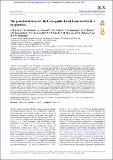Files in this item
The grandest of them all : the Lomagundi-Jatuli Event and Earth's oxygenation
Item metadata
| dc.contributor.author | Prave, A.R. | |
| dc.contributor.author | Kirsimäe, K. | |
| dc.contributor.author | Lepland, A. | |
| dc.contributor.author | Fallick, A.E. | |
| dc.contributor.author | Kreitsmann, T. | |
| dc.contributor.author | Deines, Yu.E. | |
| dc.contributor.author | Romashkin, A.E. | |
| dc.contributor.author | Rychanchik, D.V. | |
| dc.contributor.author | Medvedev, P.V. | |
| dc.contributor.author | Moussavou, M. | |
| dc.contributor.author | Bakakas, K. | |
| dc.contributor.author | Hodgskiss, M.S.W. | |
| dc.date.accessioned | 2021-07-28T15:30:09Z | |
| dc.date.available | 2021-07-28T15:30:09Z | |
| dc.date.issued | 2021-06-21 | |
| dc.identifier | 275052477 | |
| dc.identifier | 3ba1f7fa-03ae-4de9-a595-7d19ea766440 | |
| dc.identifier | 000751884400002 | |
| dc.identifier | 85120937428 | |
| dc.identifier.citation | Prave , A R , Kirsimäe , K , Lepland , A , Fallick , A E , Kreitsmann , T , Deines , Y E , Romashkin , A E , Rychanchik , D V , Medvedev , P V , Moussavou , M , Bakakas , K & Hodgskiss , M S W 2021 , ' The grandest of them all : the Lomagundi-Jatuli Event and Earth's oxygenation ' , Journal of the Geological Society , vol. Online First , jgs2021-036 . https://doi.org/10.1144/jgs2021-036 | en |
| dc.identifier.issn | 0016-7649 | |
| dc.identifier.other | RIS: urn:EA32A2FF895DCD6F966B1239374A6B3B | |
| dc.identifier.other | ORCID: /0000-0002-4614-3774/work/97129685 | |
| dc.identifier.uri | https://hdl.handle.net/10023/23664 | |
| dc.description | Funding: K.K., A.L. and T.K. received funding from Estonian Science Agency Project PRG447 and Yu.D., A.R., D.R. and P.M. were supported by the state assignment of the Institute of Geology, Karelian Research Centre of the Russian Academy of Sciences. | en |
| dc.description.abstract | The Paleoproterozoic Lomagundi–Jatuli Event (LJE) is generally considered the largest, in both amplitude and duration, positive carbonate C-isotope (δ13Ccarb) excursion in Earth history. Conventional thinking is that it represents a global perturbation of the carbon cycle between 2.3–2.1 Ga linked directly with, and in part causing, the postulated rise in atmospheric oxygen during the Great Oxidation Event. In addition to new high-resolution δ13Ccarb measurements from LJE-bearing successions of NW Russia, we compiled 14 943 δ13Ccarb values obtained from marine carbonate rocks 3.0–1.0 Ga in age and from selected Phanerozoic time intervals as a comparator of the LJE. Those data integrated with sedimentology show that, contra to consensus, the δ13Ccarb trend of the LJE is facies (i.e. palaeoenvironment) dependent. Throughout the LJE interval, the C-isotope composition of open and deeper marine settings maintained a mean δ13Ccarb value of +1.5 ± 2.4‰, comparable to those settings for most of Earth history. In contrast, the 13C-rich values that are the hallmark of the LJE are limited largely to nearshore-marine and coastal-evaporitic settings with mean δ13Ccarb values of +6.2 ± 2.0‰ and +8.1 ± 3.8‰, respectively. Our findings confirm that changes in δ13Ccarb are linked directly to facies changes and archive contemporaneous dissolved inorganic carbon pools having variable C-isotopic compositions in laterally adjacent depositional settings. The implications are that the LJE cannot be construed a priori as representative of the global carbon cycle or a planetary-scale disturbance to that cycle, nor as direct evidence for oxygenation of the ocean–atmosphere system. This requires rethinking models relying on those concepts and framing new ideas in the search for understanding the genesis of the grandest of all positive C-isotope excursions, its timing and its hypothesized linkage to oxygenation of the atmosphere. | |
| dc.format.extent | 3770091 | |
| dc.language.iso | eng | |
| dc.relation.ispartof | Journal of the Geological Society | en |
| dc.subject | Lomagundi-Jatuli Event | en |
| dc.subject | Palaeoproterozoic | en |
| dc.subject | Carbon isotope excursions | en |
| dc.subject | Great Oxidation Event | en |
| dc.subject | GE Environmental Sciences | en |
| dc.subject | QE Geology | en |
| dc.subject | DAS | en |
| dc.subject | SDG 14 - Life Below Water | en |
| dc.subject.lcc | GE | en |
| dc.subject.lcc | QE | en |
| dc.title | The grandest of them all : the Lomagundi-Jatuli Event and Earth's oxygenation | en |
| dc.type | Journal article | en |
| dc.contributor.institution | University of St Andrews. School of Earth & Environmental Sciences | en |
| dc.contributor.institution | University of St Andrews. Scottish Oceans Institute | en |
| dc.contributor.institution | University of St Andrews. St Andrews Sustainability Institute | en |
| dc.contributor.institution | University of St Andrews. St Andrews Isotope Geochemistry | en |
| dc.contributor.institution | University of St Andrews. Marine Alliance for Science & Technology Scotland | en |
| dc.identifier.doi | https://doi.org/10.1144/jgs2021-036 | |
| dc.description.status | Peer reviewed | en |
| dc.identifier.url | http://jgs.lyellcollection.org/content/early/2021/06/15/jgs2021-036.abstract | en |
This item appears in the following Collection(s)
Items in the St Andrews Research Repository are protected by copyright, with all rights reserved, unless otherwise indicated.

